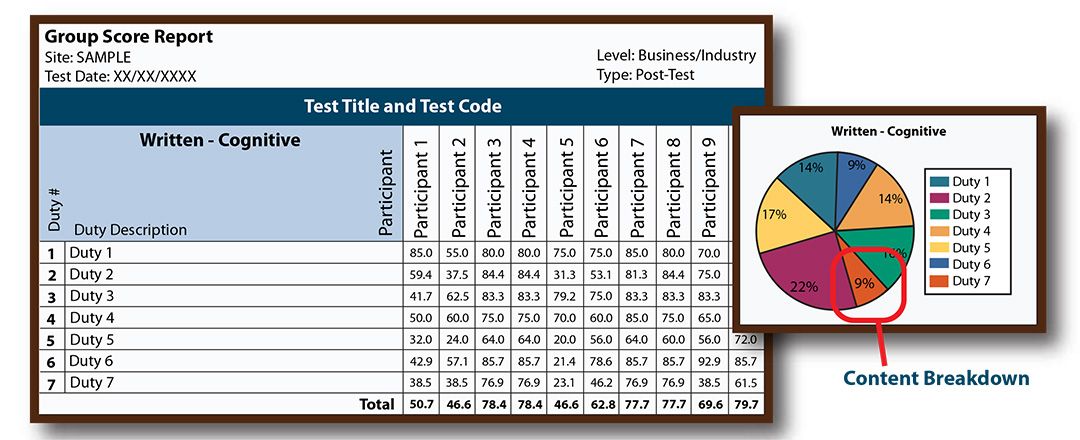Skills assessments are standardized tests designed to determine if a worker has the technical skills and knowledge to be a productive member of your organization. Here at Nocti Business Solutions, we strongly believe that the data provided by these assessments is one of the keys to building a stronger, safer, more efficient workforce. Research has shown that companies who use pre-employment tests and skills assessments are 24% more likely to have employees who exceed performance goals and also report a 39% lower turnover rate. But, you may be wondering, how does a standardized test accomplish so much? How do you move forward once you have the assessment score report in front of you?
As you may have guessed, a score report itself doesn’t instantly guarantee a safer, more competent workforce. The score is meant to guide you and inform your actions throughout the hiring and training process. Here’s a quick guide for what actions to take after getting your employee’s assessment score report.
How Skills Assessments Are Scored
First, it’s important to understand how skills assessments are scored. After a test taker completes a test, a score report is generated. This is an in-depth analysis of your employee’s overall score as well as the scores for each performance area. This report also offers comparisons to the national and state averages, and the percent of change in an employee’s score if they have taken the test before.
While the amount of data may seem overwhelming, it provides valuable insight into what the score means in a practical sense. For example, the Building Construction Occupations assessment is broken down into seven general topics. A candidate’s score report will include scores for each performance area and will compare those scores to group, state, and national averages. If your employee scored well on the electrical portion of the test, but not well on the carpentry portion, you have some immediate insight into where to focus your training efforts.

Below Average Score: Insightful Training
Let’s begin with the least desirable scenario: what if an employee scores below average on a skills assessment? Even more concerning: what if an entire group scores below average?
If this is administered as a pre-employment test, you may decide not to hire this particular candidate. If you do hire this candidate, or if the test taker is a current employee, then the skills assessment score provides specific data on their strengths and weaknesses. You now know exactly what subject areas and tasks a particular worker struggles with. This allows for highly focused and insightful training that not only makes the most of the trainer’s time, but that will also target a worker’s weak areas and lessen the overall time to competency.
If you find that multiple employees performed poorly across various skill areas, then it may be time to reevaluate your training program. Even now, your score reports provide valuable data about what areas need the most attention.
After additional training, have your employee (or employees) retake the skills assessment. The data on the second score report will include a comparison of the pre- and post-test data, giving you even further insight into how your employee has improved, and the effectiveness of your training methods.
Average Score: Targeted Upskilling
What do you do if an employee’s score meets the average? This is excellent! Your employee obviously has the skills to get the job done. However, an average score means there’s still room for improvement.
This is where upskilling comes in. Upskilling is a targeted way to help your employees become dynamic and well-rounded workers. Upskilling can be as simple as providing additional training or having a more experienced worker mentor another. It is also a way to help beat the skills gap and increase employee retention. Upskilling comes in a variety of shapes and sizes and often looks different from company to company. Some common strategies include:
- Mentoring/shadowing
- Microlearning
- Using free industry resources for education
- Virtual or video learning
- Offsite learning and education
Above Average Score: Confident Promoting
Now for the best-case scenario. What happens when a test-taker’s score is above average on a skills assessment? Congratulations! This means you’re doing a lot of things right in your organization. An employee who does well on a skills assessment may not need insightful training or upskilling. They can, however, continue to make your organization a better place by taking on more responsibilities or by filling leadership positions.
Without the precise data from a skills assessment score, it can be hard to know how to fill leadership positions, especially when choosing from a pool of similar candidates. A relevant skills assessment gives you the confidence to promote employees who will continue to have a positive impact on your organization.
Skills Assessments With NBS
At first glance, a skills assessment score report can be intimidating. It contains a lot of data, and if you aren’t familiar with the metrics and what the various terms mean, it can be difficult to know what to do next. Depending on a candidate’s score, there may be different steps to take. As we have seen, skills assessments are an extremely valuable tool for training, upskilling, and promoting. Here at Nocti Business Solutions, we want to make sure your skills assessment is as useful as possible. That’s why we offer custom skills assessments that can be tailored specifically to your organization. Our mission is to provide you with all the tools you need to build a qualified, safe, and productive workforce!

Recent Comments